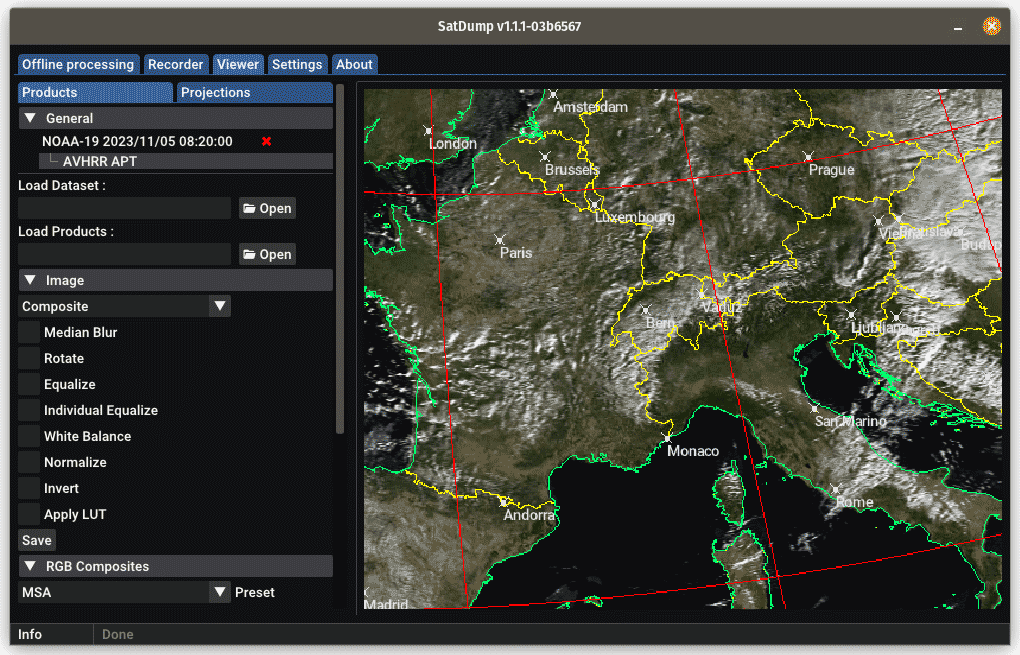Thank you to Jacopo (@lego11/IU1QPT) and Robin (@OK2AWO) for writing in and sharing with us his thoughts about how the SDR community as a whole should move on from the use of WXtoIMG, and instead switch to SatDump, which now has full feature parity with WXtoIMG and additional features too. SatDump is available on Windows, MacOS, Linux, and even on Android. An up-to-date guide for receiving APT with SatDump written by @lego11 can be found on his website here.
Historically, WXtoIMG has been the software of choice for the popular hobby of decoding NOAA APT weather satellite images with RTL-SDR and other SDRs. However, the software has unfortunately been abandoned by its authors for several years, and can now only be found on third-party websites which increases the possibility of downloading a virus. Also, a hack involving a proxy, or directly updating via a powershell script is now required to allow WXtoIMG to update its TLE/ Kepler files due to the celestrak.com to celestrak.org domain name change.
Lego11 also notes a whole host of other issues regarding vulnerabilities and bugs with WXtoIMG:
- The software is ancient and uses obsolete libraries, such as Visual C++ 2002 with .NET. These libraries are the main concern when it comes to WXtoIMG, as I don't find it particularly likely for someone to find an entry point through the software itself. However, a much more likely scenario is a virus abusing the loaded library in memory when WXtoIMG is running and using it to gain an entry point. There are at least 20 vulnerabilities affecting MSVCR70.dll, and all are well known (such as CVE-2007-0025) which makes it even more concerning. CVE-2008-4255 in particular allows for remote code execution on the user's computer, which is very serious. There are certainly many more vulnerabilities that have been exploited regarding MSVCR70, but due to the obsolescence of this software component they are usually not tracked in a CVE.
In either case, just as nobody would use Windows XP as a daily driver in 2024, nobody should use WXtoIMG as a matter of caution, even if the above mentioned vulnerabilities were not present.
As for the bugs, there are many. Here's a list of the most important ones:
- Cannot update TLE without external software, complicating the experience for newcomers and adding extra failure points
- Map overlay doesn't work properly most of the times, especially if the user starts to receive the satellite before it is at least at 1° elevation
- WXtoIMG will crash if Microsoft Defender starts a memory scan during a pass. This will lose the recording
- WXtoIMG uses an outdated Win32 API to access audio. This doesn't always work on Windows 11 and Microsoft has stated that it will be removed soon.
- WXtoIMG uses ALSA on Linux. The vast majority of Linux distributions don't support ALSA directly anymore, and WXtoIMG cannot work through an audio server (e.g. Pulseaudio) like all Linux applications are supposed to. Therefore, live recording doesn't work on Linux at all.
- WXtoIMG doesn't run on MacOS anymore, as the system will refuse execution due to security problems and missing libraries.
- WXtoIMG cannot support wav files from e.g. SDR# or SDR++ without using a third party tool such as NOAA-APT.
- If a user moves or copies a recorded WAV file (see above), the map overlay will no longer work.
- WXtoIMG is especially sensitive to concurrent CPU usage, which will result in "tears" on the image (as is evident on the images in the guy's tutorial). It cannot handle multitasking well on systems more modern than Windows XP due to changes in how the CPU scheduler works in more modern kernels.
- WXtoIMG will lock up and then crash if the user starts it without first having updated TLEs due to missing NOAA-17. This is very serious, as it happens to newcomers all the time. It is one of the top support request emails/messages I receive. It is not possible to fix this crash easily.
- WXtoIMG doesn't have updated coefficients for calibration, therefore NOAA-15 will look excessively cold compared to other satellites.

